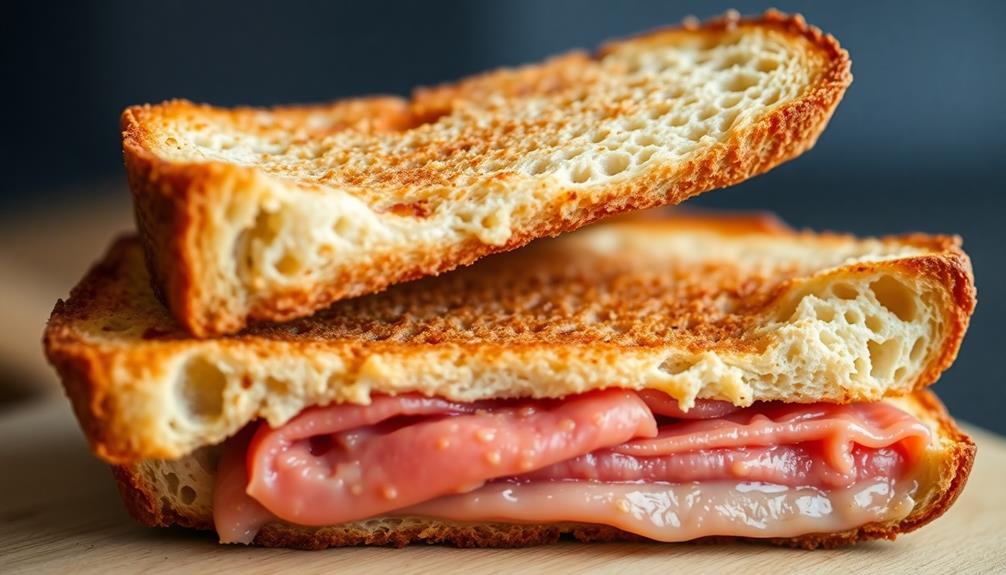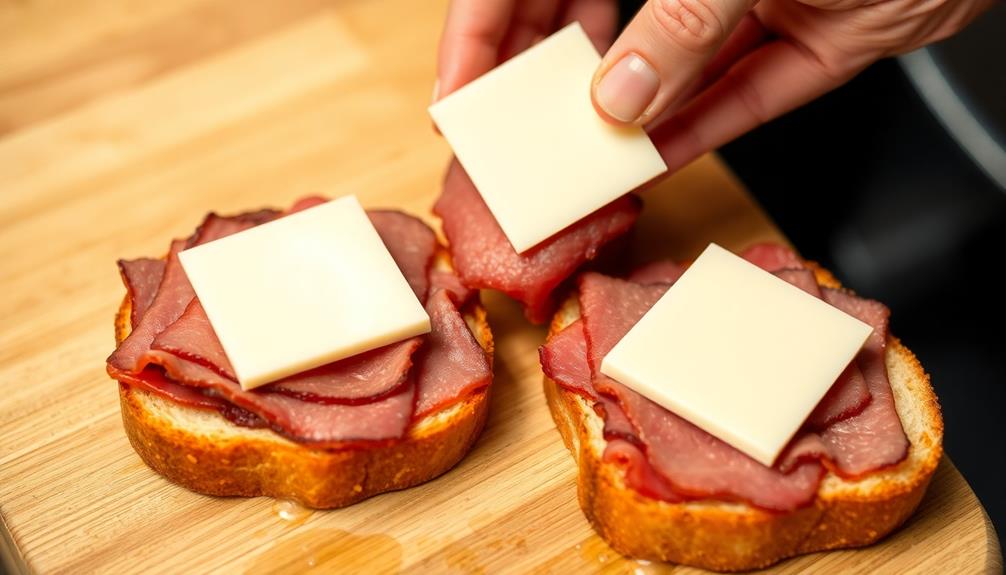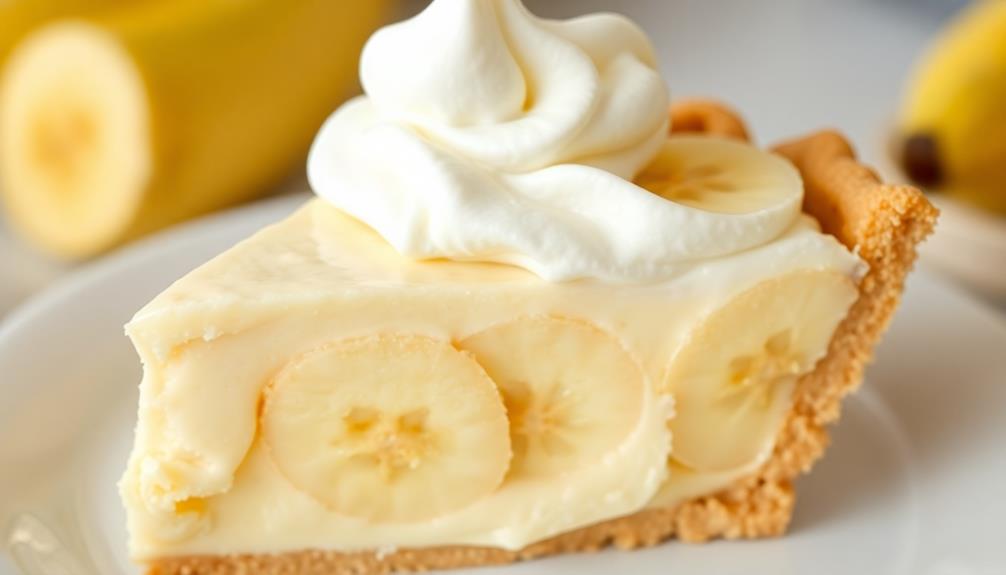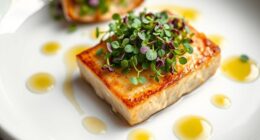The Reuben sandwich is a classic American dish that's been delighting taste buds for over a century. This mouthwatering creation combines tender corned beef, tangy sauerkraut, melted Swiss cheese, and creamy Russian dressing nestled between slices of crisp, buttery rye bread. To make the perfect Reuben, you'll start by toasting the rye bread to golden perfection, then layer on the flavorful ingredients and cook it to gooey, irresistible satisfaction. It's no wonder the Reuben has become a beloved deli staple across the country – and if you keep reading, you'll learn the secrets to making it at home.
Key Takeaways
- The Reuben sandwich is a classic American dish that originated in the early 20th century, created by Reuben Kulakofsky in Omaha, Nebraska.
- The signature ingredients of a Reuben sandwich include rye bread, corned beef, Swiss cheese, sauerkraut, and Russian dressing.
- Toasting the rye bread provides the perfect crispy exterior to support the rich and flavorful fillings.
- Generously spreading the tangy Russian dressing and layering the sauerkraut and melted Swiss cheese balance the saltiness of the corned beef.
- The Reuben sandwich has become a beloved deli staple across the United States, known for its satisfying combination of flavors and textures.
History
According to historical accounts, the Reuben sandwich was first created in the early 20th century.
It's believed to have been invented by a man named Reuben Kulakofsky, who owned a hotel in Omaha, Nebraska. He came up with the delicious combination of rye bread, corned beef, Swiss cheese, sauerkraut, and Russian dressing.
The Reuben soon became a popular menu item at the hotel, and the sandwich's fame started to spread.
Over time, it became a classic deli staple across the United States. People loved the savory flavors and the perfect balance of textures – the crunchy bread, the tender corned beef, the tangy sauerkraut, and the creamy dressing.
Today, the Reuben is still a beloved sandwich, enjoyed by people of all ages.
Whether you're grabbing a quick lunch or settling in for a leisurely meal, the Reuben is always a satisfying choice. Its history and delicious taste make it a true American classic.
Cooking Steps
To assemble the Reuben sandwich, begin by buttering the outsides of the rye bread slices. This will give the bread a delicious, golden-brown crunch when cooked.
Next, layer the corned beef, sauerkraut, and Swiss cheese on one slice of bread. Be generous with the fillings – you want all the flavors to come through in every bite!
Spread some thousand island dressing on the other slice of bread, then place it on top of the filled slice to create a sandwich.
Heat a skillet or griddle over medium heat and add the sandwich. Cook for 3-4 minutes per side, pressing down gently with a spatula to help the bread get crispy and the cheese melt.
Once the sandwich is golden brown and the cheese is melted, remove it from the heat. Slice it in half diagonally and serve hot, with any extra thousand island dressing on the side for dipping.
Enjoy the perfect balance of salty, tangy, and savory in every delicious bite!
Step 1. Toast the Rye Bread

The rye bread's toasting is a crucial step in assembling the perfect Reuben sandwich.
You'll want to lightly toast the slices until they're golden brown and crispy on the outside, but still soft on the inside. This gives the bread the perfect texture to soak up all the delicious flavors of the sandwich fillings.
To toast the rye bread, simply place the slices in a toaster or under the broiler, keeping a close eye on them to prevent burning.
Once they're toasted to your liking, remove them from the heat and set them aside. Remember, the bread should be just lightly crisp, not dry or hard. This will allow it to hold up to the weight of the sauerkraut, corned beef, and Swiss cheese without falling apart.
With the rye bread perfectly toasted, you're one step closer to enjoying a mouthwatering Reuben sandwich.
The next task is to assemble the rest of the ingredients and bring this classic deli favorite to life.
Step 2. Spread Russian Dressing Generously

Next, generously spread a layer of tangy Russian dressing over the toasted rye bread. This dressing is the perfect complement to the bold flavors of the Reuben.
With its blend of mayonnaise, ketchup, and spices, the dressing adds a delightful creaminess and zest to the sandwich. Be sure to cover the entire surface of the bread, leaving no dry spots. The dressing will soak into the toasted rye, creating a delicious, cohesive base for the other ingredients.
Now, the sandwich is really starting to come together! The dressing will provide a tangy, savory contrast to the salty corned beef and the sauerkraut's subtle acidity. Its richness will also balance the caraway-infused rye bread.
Feel free to be generous with the dressing – you want to ensure every bite is packed with flavor. Next, it's time to layer on the sauerkraut and corned beef, taking your Reuben to new heights of deliciousness.
Step 3. Layer With Sauerkraut

With the dressing generously spread, it's time to layer on the sauerkraut. This tangy, fermented cabbage adds the perfect zing to your Reuben sandwich.
Grab a handful of the sauerkraut and spread it evenly over the dressing. Make sure to cover the entire surface, creating a delicious sauerkraut bed for the corned beef to rest upon.
The sauerkraut's sour notes will beautifully complement the richness of the dressing and the saltiness of the corned beef. As you bite into your Reuben, the sauerkraut will provide a satisfying crunch, followed by its tantalizing flavor.
Its vibrant color will also add a gorgeous pop of visual appeal to your sandwich creation.
Don't be shy with the sauerkraut – layer it on generously! The more sauerkraut, the more flavor and texture you'll enjoy in every bite of your Reuben masterpiece.
Step 4. Add Shredded Swiss Cheese

After layering the sauerkraut, you'll next want to add a generous amount of shredded Swiss cheese. This melty, creamy cheese is the perfect complement to the tangy sauerkraut and robust corned beef. Gently sprinkle the cheese over the sauerkraut, making sure to cover the entire surface.
You'll want to use about 1/2 cup of shredded Swiss cheese per sandwich. The cheese will melt into the other ingredients, creating a delicious, cohesive flavor.
Once the cheese is in place, you're almost ready to assemble your Reuben. The Swiss cheese adds a lovely richness that balances the acidity of the sauerkraut and the saltiness of the corned beef.
As the sandwich cooks, the cheese will become gooey and irresistible. Be generous with the cheese – you can never have too much of that creamy, melty goodness!
With the sauerkraut and Swiss cheese in place, you're well on your way to constructing the perfect Reuben sandwich.
Step 5. Add Corned Beef

The star of the Reuben sandwich is the corned beef. This savory, thinly sliced meat is the backbone of the dish. When selecting corned beef, look for a piece that's well-marbled and has a nice pink hue. The fat content is important, as it helps to keep the beef moist and flavorful as it cooks.
Once you've got your corned beef, the next step is to add it to the sandwich. Pile on a generous portion, making sure to cover the surface of the rye bread. The corned beef should be the star of the show, so don't be shy with the amount you use.
As the sandwich cooks, the beef will warm through and become even more delicious. Be sure to layer the corned beef evenly, so that every bite is packed with that signature Reuben flavor.
With the shredded Swiss cheese already in place, the corned beef ties the whole sandwich together, creating a mouthwatering masterpiece.
Final Thoughts
Ultimately, the Reuben sandwich is a classic American dish that has stood the test of time. With its mouthwatering combination of tender corned beef, tangy sauerkraut, and melty Swiss cheese, it's no wonder this sandwich has become a beloved staple.
What really sets the Reuben apart is the way the flavors and textures come together in perfect harmony. The crisp, buttery rye bread provides the perfect canvas for the rich, savory fillings, while the thousand island dressing ties it all together with its tangy-sweet flavor.
Whether you're enjoying it for lunch or as a satisfying dinner, the Reuben is sure to leave you feeling satisfied and content.
Frequently Asked Questions
What Bread Is Best for a Reuben Sandwich?
When it comes to the perfect bread for a Reuben sandwich, you've got options! Rye bread is the classic choice, with its bold, tangy flavor that pairs perfectly with the salty corned beef, sauerkraut, and melted Swiss cheese.
But don't be afraid to get creative! Pumpernickel or sourdough can also work wonderfully, adding their own unique twist to this beloved sandwich.
The key is to choose a bread that's sturdy enough to hold up to all the delicious fillings, so you can dive in and enjoy every tasty bite.
Can I Make a Reuben Sandwich Without Sauerkraut?
Can you make a Reuben sandwich without sauerkraut? Absolutely! While sauerkraut is a classic ingredient, you don't need it to enjoy this delicious sandwich.
You can easily swap it out for other crunchy, tangy toppings like coleslaw or even just extra slices of juicy corned beef. The key is piling on the flavors – rye bread, Swiss cheese, and a zesty Thousand Island dressing create that perfect Reuben taste.
Get creative and make it your own!
How Do I Reheat a Leftover Reuben Sandwich?
Reheating a leftover Reuben sandwich is a breeze!
First, preheat your oven to 350°F (175°C). Wrap the sandwich in foil to keep it moist and place it on a baking sheet. Heat it for about 10 minutes, or until it's nice and warm.
You can also use the microwave, but be careful not to overdo it, as it can make the bread a bit soggy. Just heat it in 30-second intervals until it's perfect.
Enjoy your tasty Reuben sandwich!
Can I Substitute Other Meats in a Reuben?
Absolutely! You can substitute other meats in a Reuben sandwich to give it a unique twist.
Instead of the traditional corned beef, try using pastrami, turkey, or even roast beef. Each type of meat will add its own distinct flavor and texture to the sandwich.
Don't be afraid to experiment – the key is finding a meat that pairs well with the sauerkraut, Swiss cheese, and Russian dressing.
Get creative and make the Reuben your own!
Is a Reuben Sandwich Healthy?
Is a Reuben sandwich healthy? Well, that's a great question!
Reuben sandwiches can be a bit tricky when it comes to nutrition. They usually have lots of tasty ingredients like corned beef, sauerkraut, and Swiss cheese, but those things can be high in fat and sodium.
The good news is you can make some simple swaps to make a Reuben a bit healthier, like using leaner meats or swapping the sauerkraut for something lighter.
With a few tweaks, you can enjoy the delicious flavors of a Reuben while keeping it on the healthier side!










